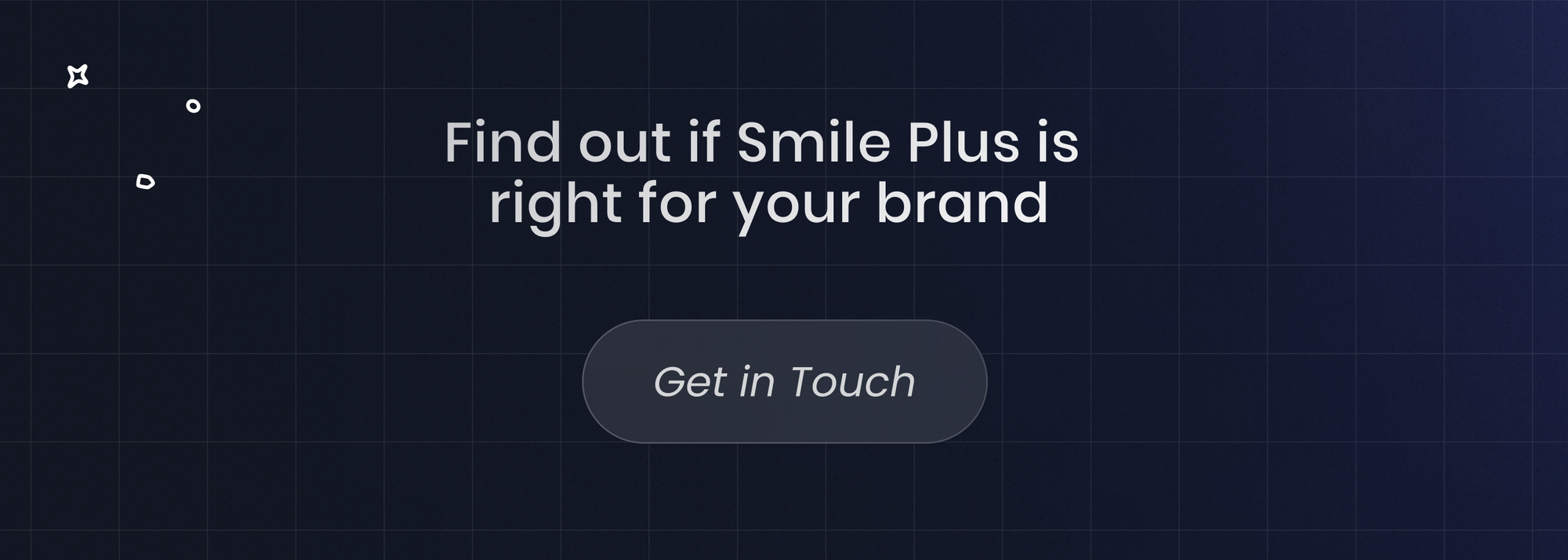Loyalty programs are part of a larger retention strategy that brings customers back to your store, builds a loyal following, and boosts customer lifetime value (CLV) and repeat purchase rates. No one denies the importance of customer loyalty. But how do major ecommerce brands build and sustain customer loyalty?
Yes, by offering valuable products, but more importantly, by giving customers a reason to continue shopping that goes beyond the products.
One of the best ways is through loyalty programs that incentivize customers to return to your store for repeat purchases. Let’s go over exactly how you can set up a loyalty program for your Shopify Plus store, step by step.
Why Smile.io Plus and Shopify Plus
Smile.io powers more than 100,000 ecommerce brands across various industries. Smile Plus is the top-tier solution for major Shopify Plus brands to power their loyalty programs. Brands such as Blume, Liquid Death, Monos, and many more.
Smile for Shopify Plus is a total rewards solution that is flexible, elegant, and easy to manage by your non-technical team and simple to use by your customers.
Based on our data at Smile.io, from a sample of over 1.1 billion shoppers and 250,000 ecommerce brands, 41% of an ecommerce store’s revenue is created by only 8% of its customers, and your top 5% of customers generate 35%. This 5% is made up of your most loyal repeat customers, making it clear that repeat customers generate revenue and are extremely profitable!
After one purchase, a customer has a 27% chance of returning to your store. While that’s not a horrible return rate, if you can get that customer to come back and make a second and third purchase, they have a 49% and 62% chance of making another purchase, respectively. All are made possible through the power of an effective loyalty program.
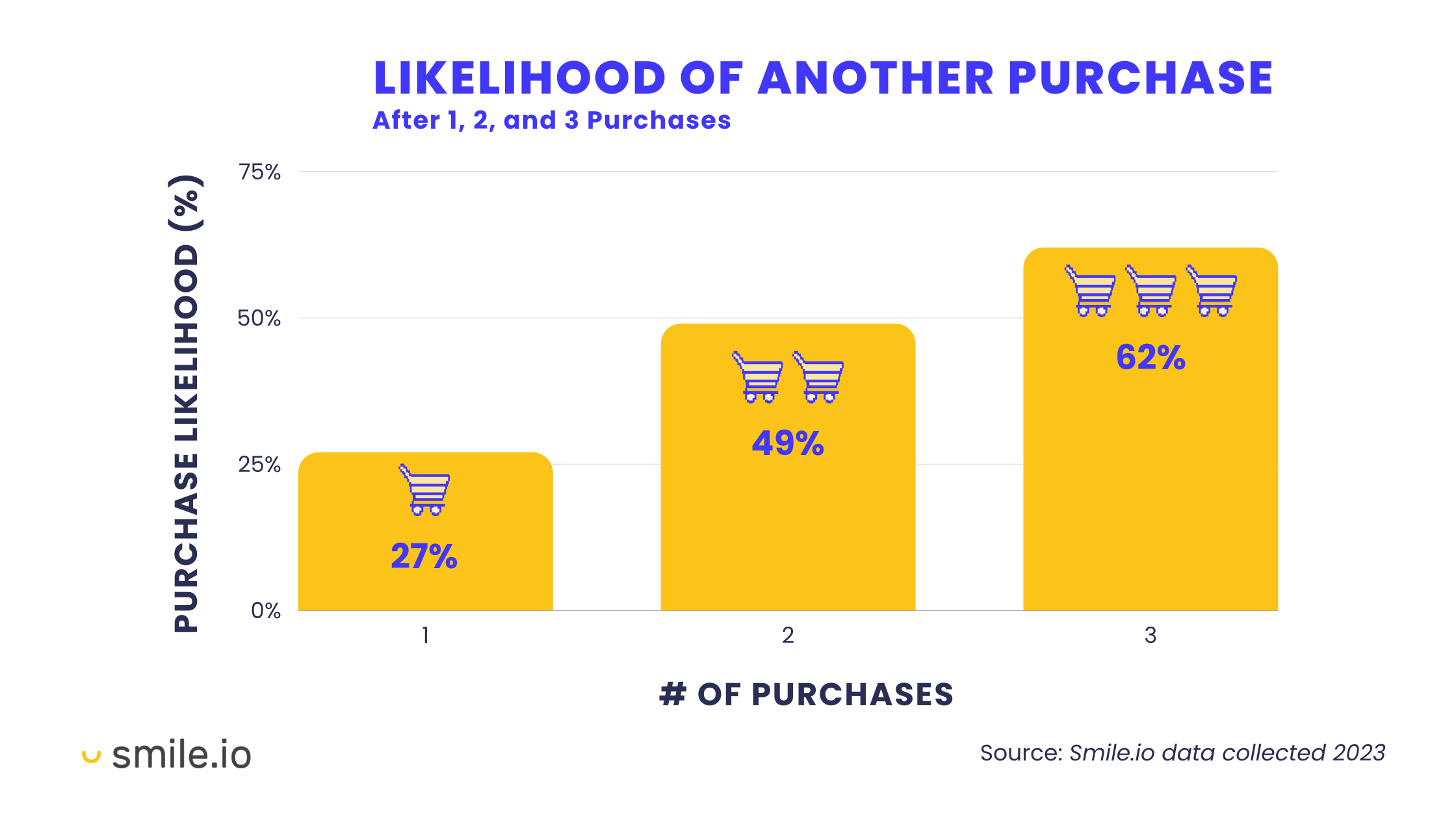
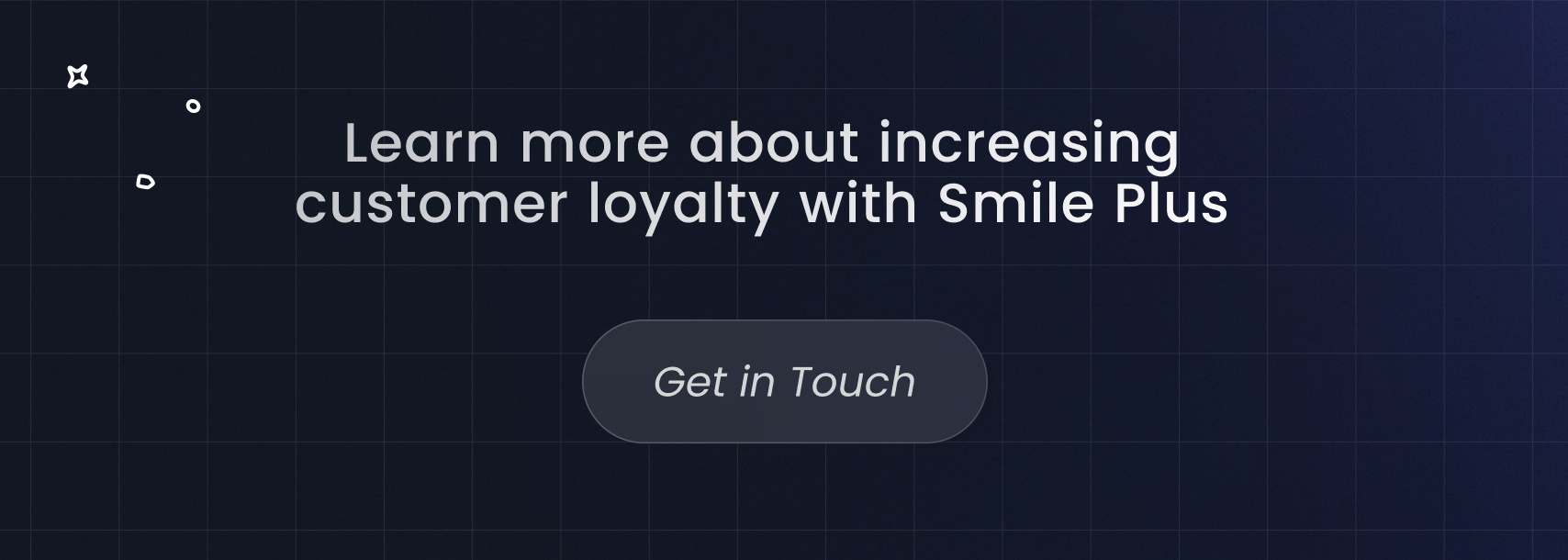
How to set up a Shopify Plus loyalty program
Through a Smile loyalty program, you can offer rewards, discounts, VIP tiers, and other incentives as a way to acquire, engage, and, most importantly, retain customers. Loyalty programs are a customer retention tool that successfully encourages customers to buy and support your business over your competitors and return for repeat purchases.
Connect with our team member for help with install, or simply select “install” in the app store. With the Smile Plus plan, Shopify Plus merchants gain access to top features that make your loyalty program a major player in your industry. Rewarding customers is intuitive, simple, and seamless for any customer to use.
Unlock API access, powerful reporting tools, and gain access to exclusive features such as the ability to offer gift card rewards to avoid the limitations with coupon stacking and points redemption at checkout to offer a smoother customer checkout experience.
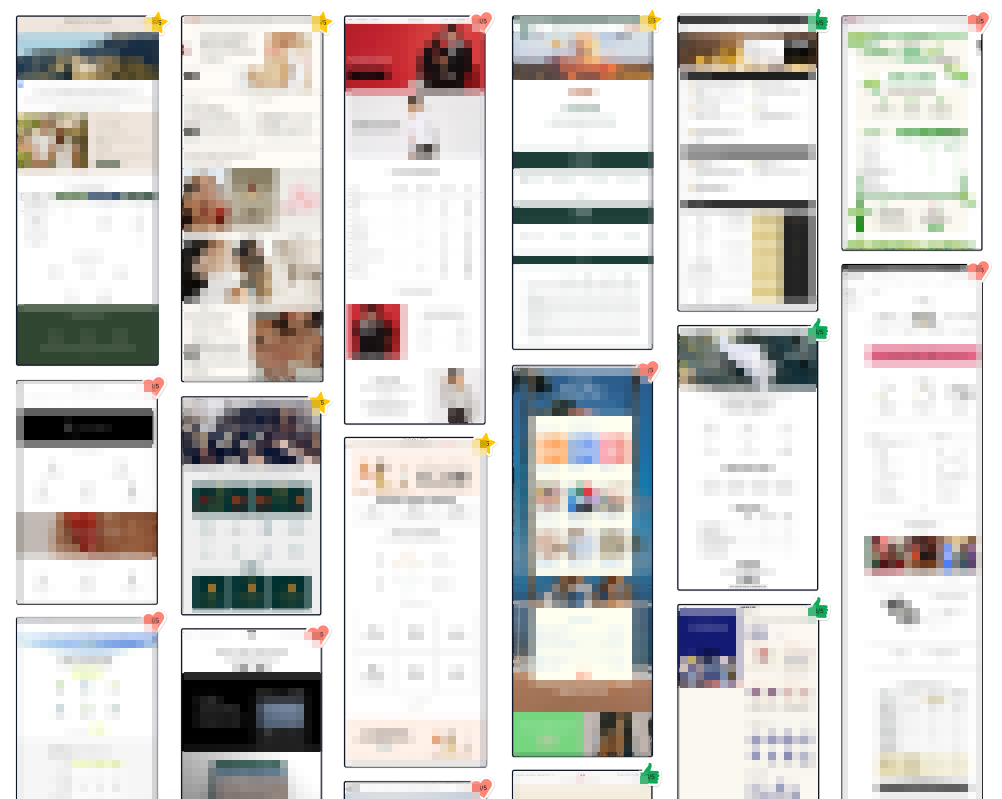
Step 1. Know when you’re ready to launch a loyalty program
In order for your loyalty program to be successful, you need to have a strong motivator for implementing one in the first place. One of the strongest foundations for launching a loyalty program is knowing your customers.
Ask yourself these questions about your customers:
- What are they asking from you?
- What are the key characteristics of how and when they shop with you?
- How healthy are your current retention metrics?
Understanding your customers will help you craft a strong strategy when setting up and launching your loyalty program. There are a few key indicators of a good loyalty program. Effective loyalty programs bring customers back, create loyal customers who spend more money, and motivate returning customers to spend more often.
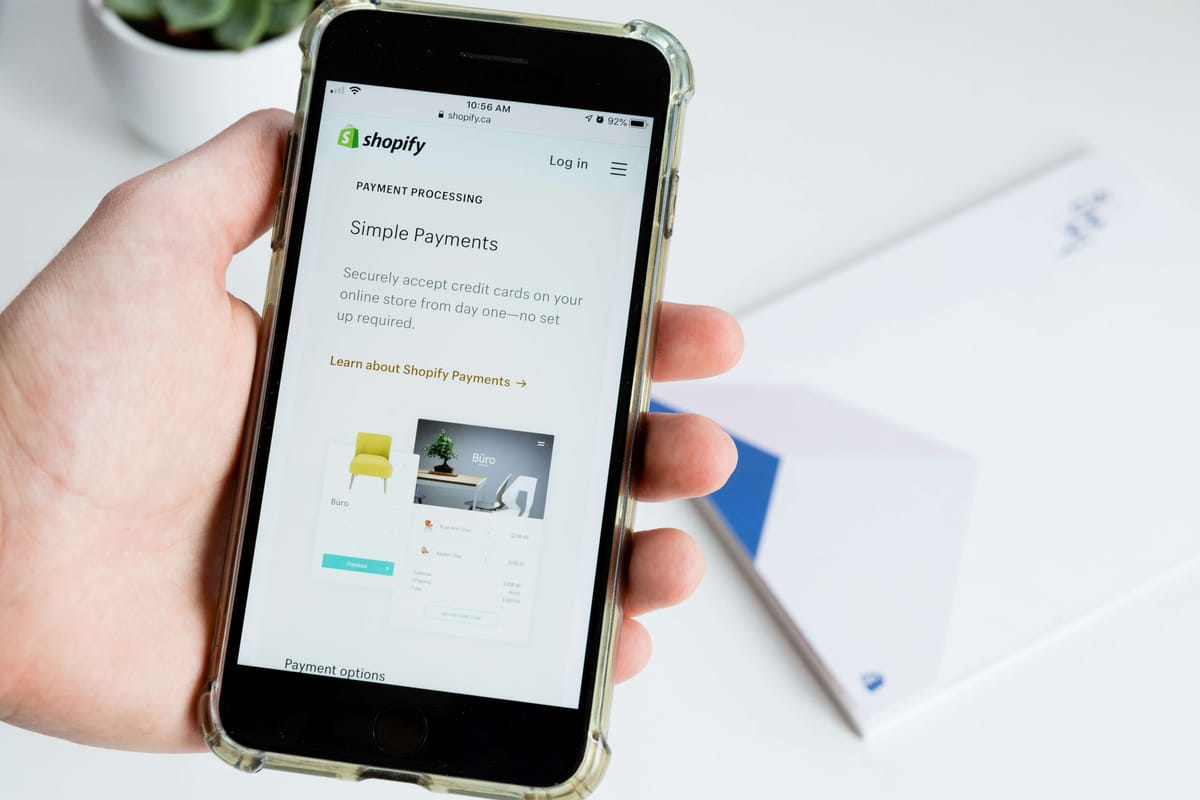
Step 2. Decide what you will reward points for
The next important step in setting up a Shopify Plus loyalty program is deciding what actions you will reward points for. Some of the main types of point-earning actions Shopify Plus brands reward customers for are:
- Setting up an account
- Celebrating a birthday
- Making a purchase
- Engaging with your store on social media
- Reviewing a product
- Referring friends and family
Luggage brand Monos rewards customers for signing up, placing orders, following the brand on social media, leaving reviews, celebrating a birthday, and referring customers. They make these actions attractive with generous offers like a sign-up bonus of 100 Monos Miles (points) and a referral reward of $20 off—Give your friend $20 off their purchase of $200 or more, and you’ll get rewarded with $20 off, too.
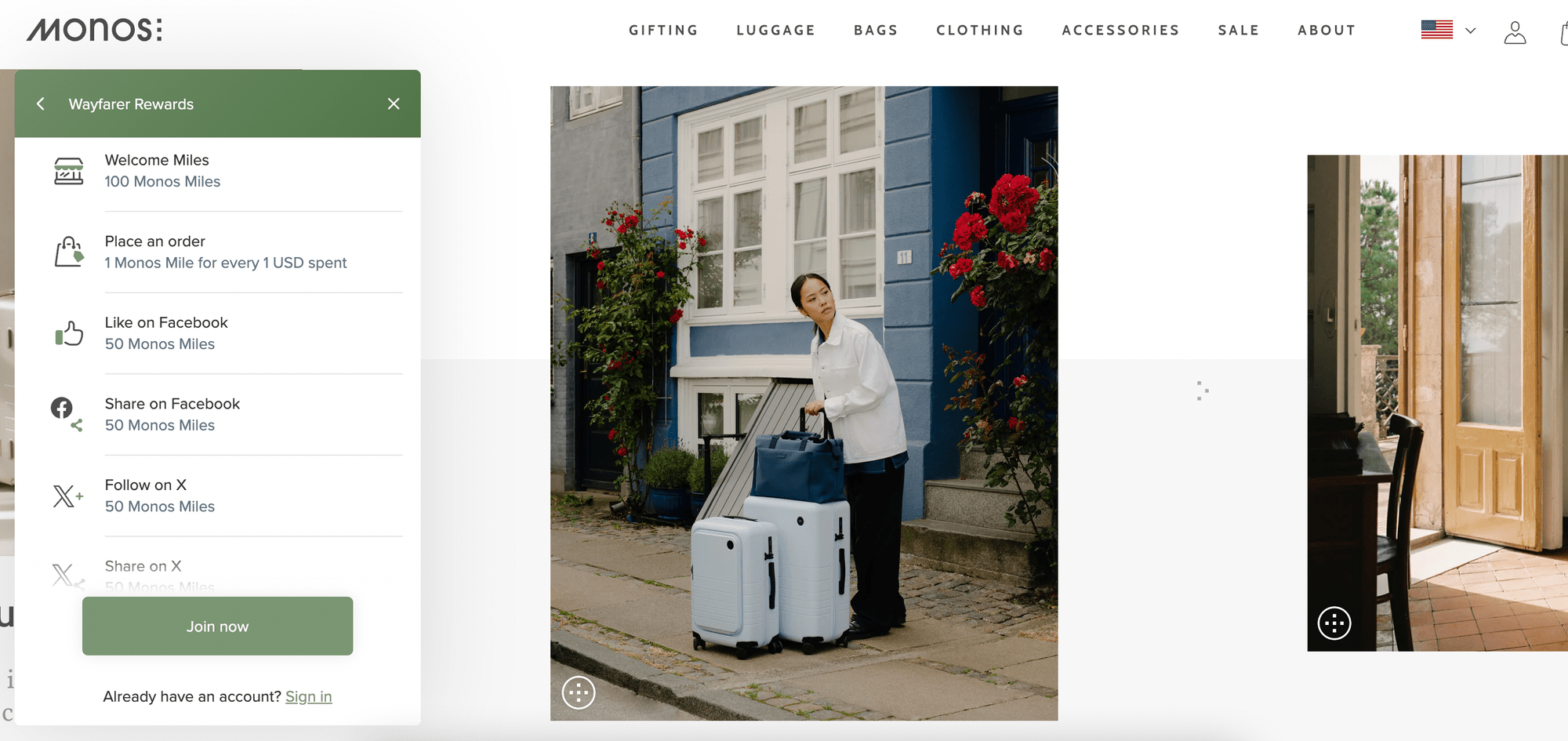
Setting up an account
Offer introductory points that will begin to build up a points balance for your customers. Introductory (or sign-up) points also allow you to capture first-party data from your customers, such as names and email addresses. When starting with Smile.io, you will be asked to select what you want to reward for. Offering sign-up points allows you to get started quickly.
Celebrating a birthday
Who doesn’t like to feel special on their birthday? A fantastic way to engage dormant customers is to automatically reward them with a generous amount of birthday points, followed by a points balance reminder email. It’s a perfect recipe to get customers back to your store and shop. For example, Monos rewards customers with 200 points for their birthdays.
Shares and follows on social media
Smile.io allows you to reward points when shoppers follow different social media accounts. For example, you can earn 100 points for following a brand on Instagram, and an additional 100 points for sharing products on Facebook. The points are rewarded when a shopper follows the link through the loyalty panel to the social media page.

Social media is key to growing a brand and community. Getting shoppers to follow your ecommerce brand’s social page while earning points can be a good incentive for them to continue to engage with your brand even off your website.
Rewarding for photo and video reviews
Reviews are a key foundation to showing potential customers why to shop with you over a competitor. Reviews act as social proof and help potential customers build trust in the ecommerce brand.
Loyalty programs can help you earn more reviews by rewarding customers for leaving a photo or a video review. Monos rewards customers with 100 points for leaving a review, which translates to a $5 off reward. Smile.io integrates with various review Shopify apps such as Judge.me, or Fera.ai, which can easily allow you to display those reviews on your site.
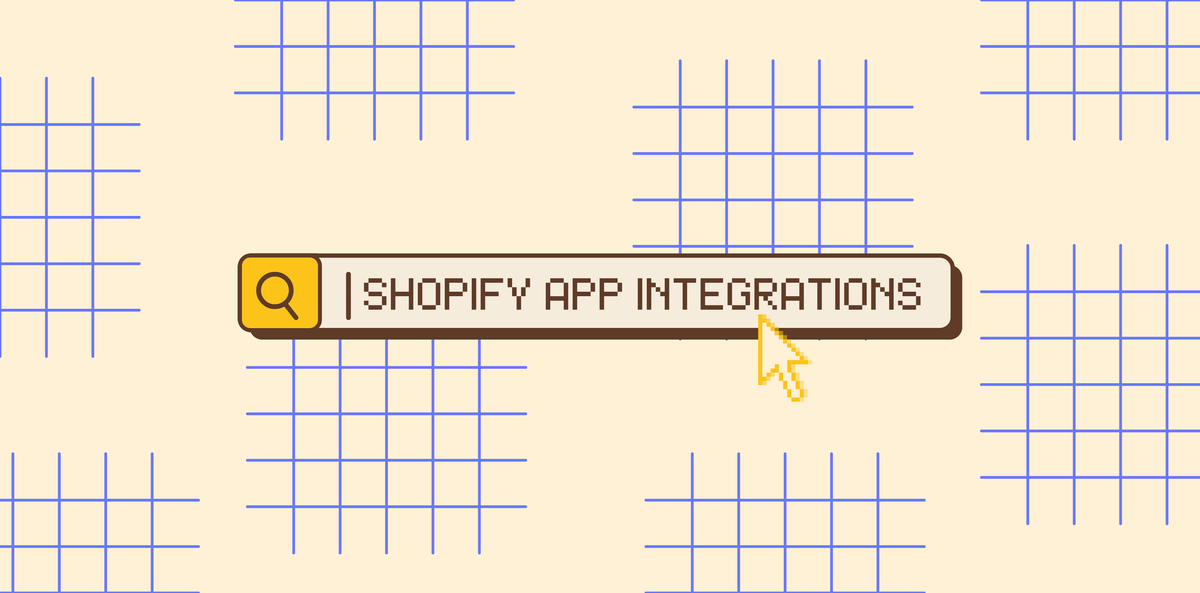
Referrals
Referral programs are a simple way to get your loyal customers to introduce your brand to their network. Referrals expand your marketing reach and reduce marketing costs because you have brand advocates doing the work. Incentivize these with a referral discount for both the person making the referral and the person being referred. Referrals allow ecommerce brands to measure word-of-mouth marketing in real-time.

Some ecommerce brands offer a mutual exchange of discounts for both parties. Other ecommerce brands offer points to the person making a referral and a generous discount to the first-time shopper receiving the referral.
Step 3: Give your loyalty program a name
Naming your loyalty program is an important step in your overall strategy since it can become a recognizable aspect of your overall ecommerce brand. Some of the largest loyalty programs in the world are just as recognizable as the brand. Loyalty programs can become synonymous with brand loyalty. Think Sephora’s Beauty Insider program, Delta’s SkyMiles loyalty program, or Starbucks Rewards.
Through market research and speaking to your customers, get creative and make sure your loyalty program name aligns with your business name, products, and what you’re known for.
The best loyalty programs perform better when they stand out on their own and form an identity that is an extension of the overall brand. If you call the program “My Shopify Store’s Loyalty Program,” your customers are going to think it’s dull and lacks value.
The same can be applied to how you are naming your loyalty currency. If you just call your currency “points,” it does not attract the same attention that something unique would. Give your customers something to get excited about.
One simple way to brainstorm ideas is to look at your existing marketing channels to determine your brand voice:
- What is the tone and language of how you communicate with your customers?
- Do you use a lot of emojis?
- Are you cheeky or provocative?
- Are you casual or professional?
Your program name needs to clearly communicate the value of joining your program.
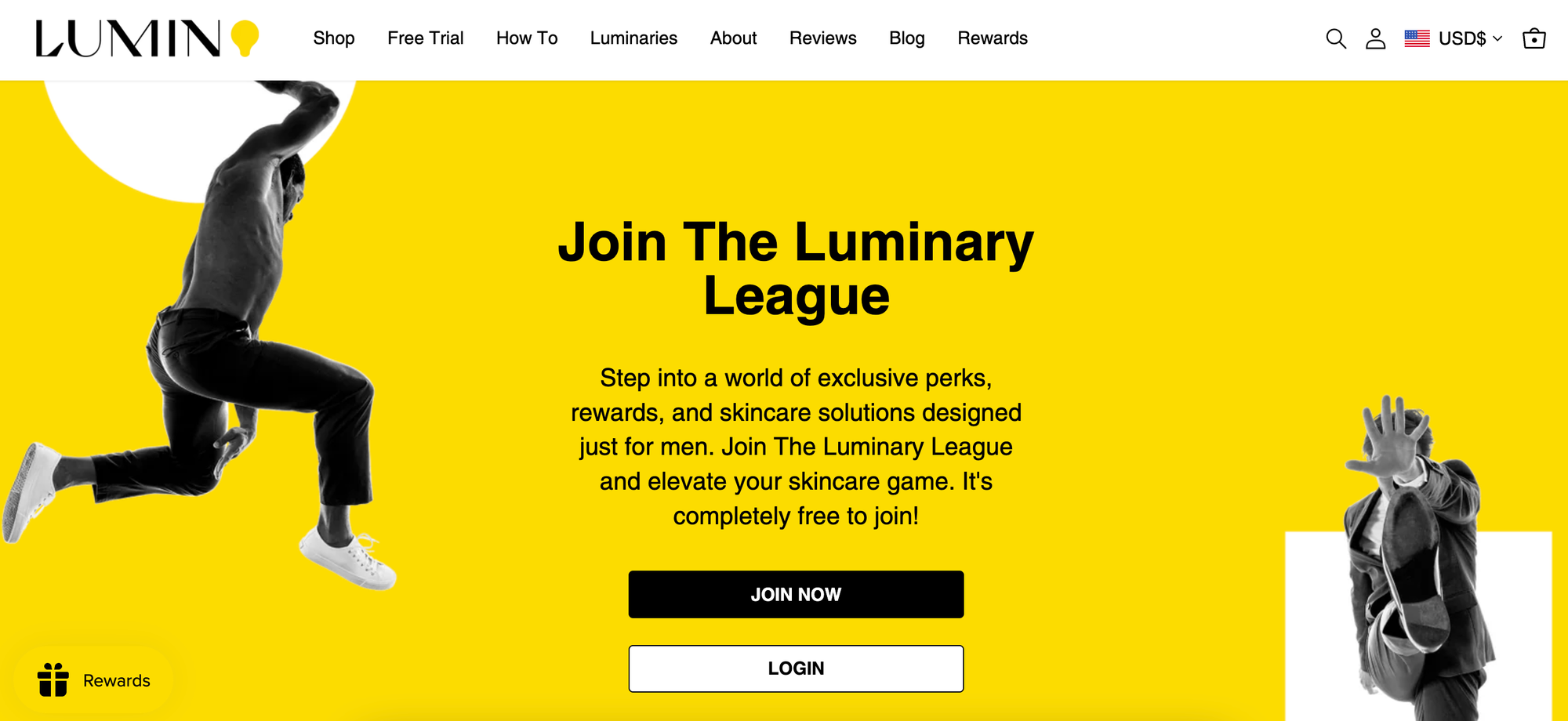
Men skincare brand Lumin appropriately names its loyalty and rewards program, The Luminary League, and its currency, Lumin Coins. This conveys the message to its audience of the bright and team-oriented community they can be a part of. It conveys value to those who join.
Some tips for naming your Shopify Plus loyalty program:
- Establish an emotion.
- Align with your products, brand values, and what your business is known for.
- Incorporate your loyalty program currency.
- Analyze how you speak to your customers across all your channels.
Step 4. Decide what your points and rewards are worth
As a rule of thumb, Smile.io recommends giving 3-10% back in points for every dollar spent. At the same time, you don’t want customers redeeming a discount on their first purchase. You want them to build points to return for a repeat purchase to redeem and spend those points.
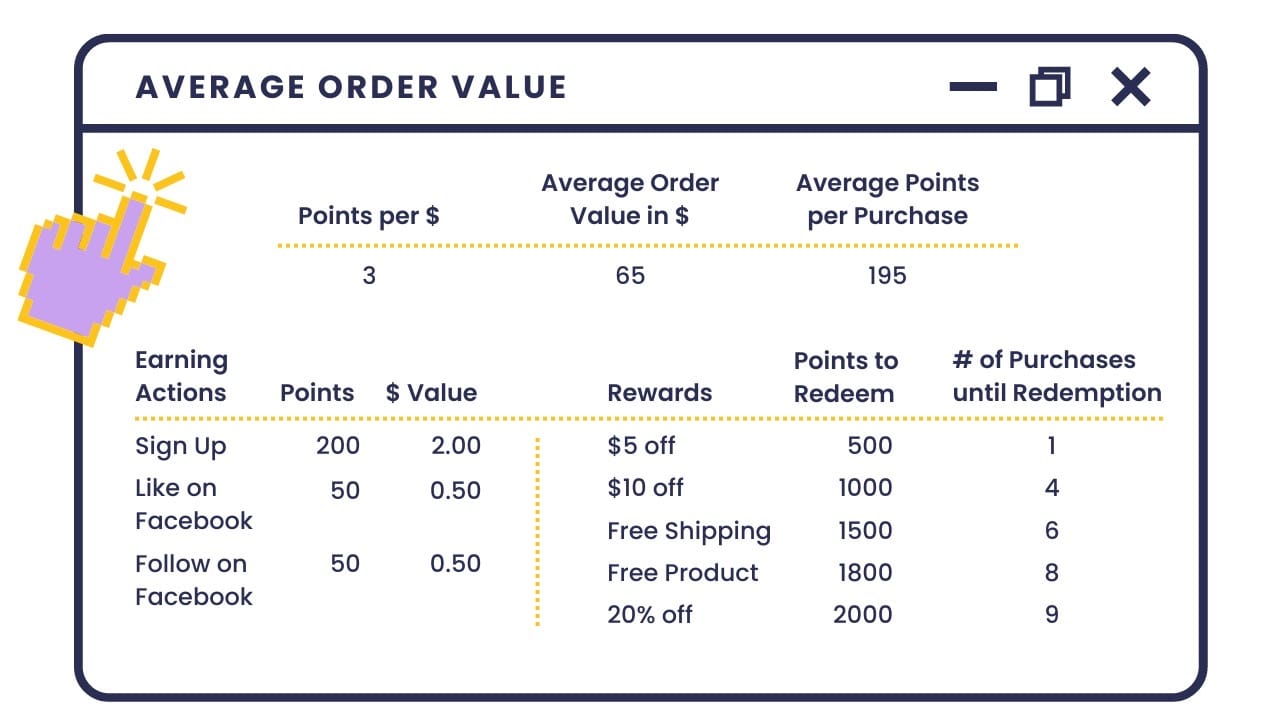
Tips for deciding what your points are worth:
- Give 3-10% back to customers in points for every dollar spent.
- Don’t give away enough points to redeem a reward before a purchase is made.
- You want customers to come back. Ensure customers need to make 1-3 purchases before redeeming the first reward.
- Set your first reward just above the number of points customers can earn without making a purchase.
Step 5: How many points do I give for actions
One of the key ways loyalty programs become successful (and used by customers) is by rewarding points generously. You don’t want customers to have to make 4, 5, or more purchases just to redeem one reward. You want your reward and points structure to be attainable and valuable.
Once you have calculated what your points are worth and the types of rewards you’re giving, you now need to decide how many points you are going to give for the actions in your Shopify Plus loyalty program.
If you know the exact value of a social follow or how much a referred customer spends on average at your store, you can use that information. But if you're just getting started, these insights will show you how to calculate how many points each action should be worth.

Account registration = half the points of your first reward
Introductory points (signing up for an account) must be a generous amount of points. And often the most a first-time customer can receive. Smile.io indicates a good rule of thumb is to offer about half of the number of points needed for your first reward. So, if you offer $5 off for 500 points, then a 250 sign-up bonus is great!
This will motivate customers to create an account they will use to reach that reward. It ensures customers use their account instead of creating a new account every time they shop with you to receive that discount. By building your customer's balance with points, you incentivize them to return for a second purchase.
Reviews = half the points of your first reward
Similar to the amount of points to sign up for an account, we recommend offering about half the points needed to cash in that first reward. This is because your customers have already purchased from your store, and now you need them to be incentivized to come back to leave a review.
Celebrating a birthday = half the points of your first reward
One rule within the Smile.io app is that customers need to enter their birthday at least 30 days in advance before being able to redeem birthday bonus points. Since you should only offer this once a year, we recommend you offer up to half the amount of points needed for your first reward.
Referrals = mutual points or the same discount amount to both parties
To engage customers to make a referral to their community, you want to reward both parties for a successful referral. Turning your current customers into brand advocates requires an incentive.

It’s estimated that referred customers have a 37% higher retention rate compared to other customers gained through other marketing channels. A very powerful force to motivate someone’s behavior is to show them what’s in it for them. Reward both new and returning customers equally so they find value in your program.
You can decide to give both parties the same amount of points, a price-based discount, or a percentage-based discount.
Social media follows = cumulatively below the first reward amount
The total points value from all your social actions and sign-up bonus should not exceed the points required to cash in that first reward. For example, if we maintain that your first reward is 500 points = $5 off and your sign-up bonus is 250 points, you can offer 50 points for each social media follow. As long as you don’t offer more than 5 social media earning actions, you’ll still be under that first reward threshold.
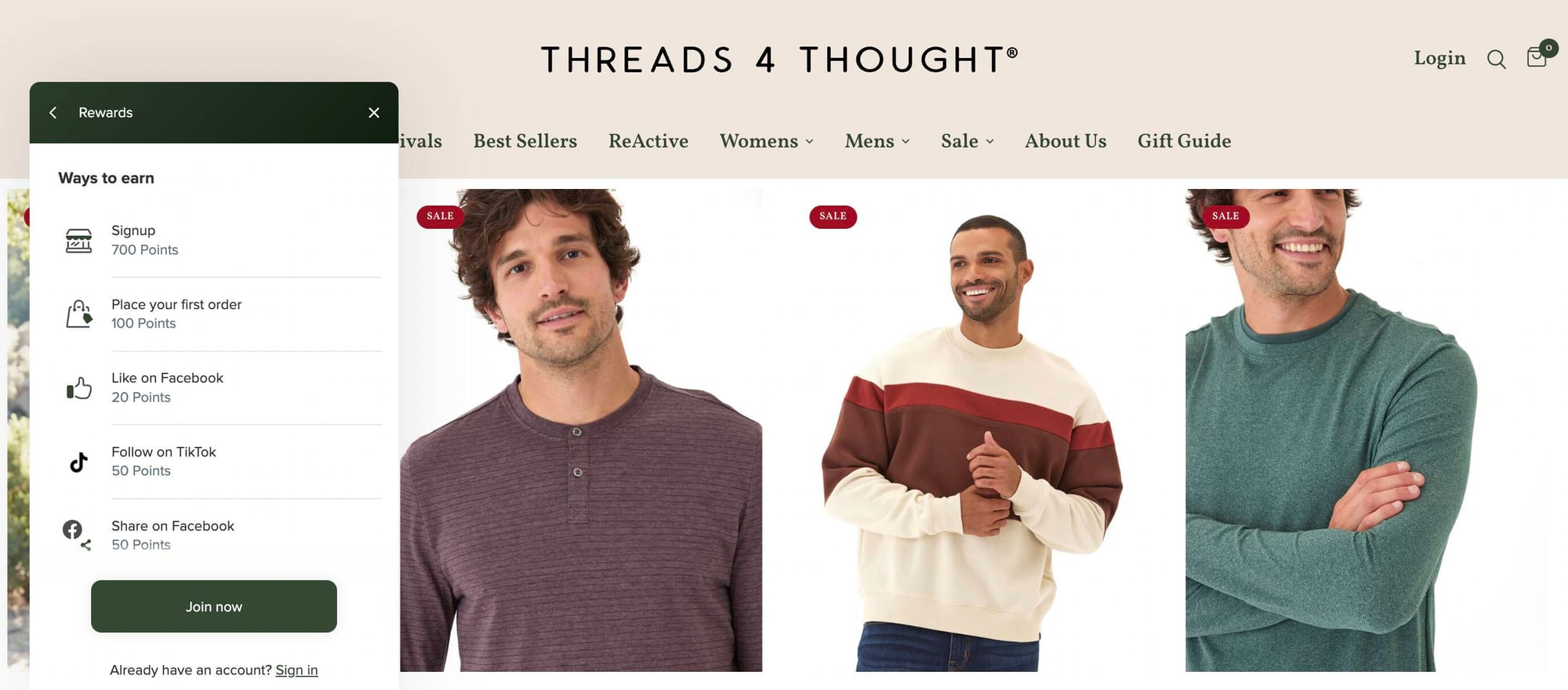
Customers can start redeeming a $25 off coupon on their second purchase with the apparel brand Threads 4 Thought. To redeem the $25 discount, Threads 4 Thought's loyalty program, requires 1500 points. Before making a purchase, customers can earn 700 points for joining its loyalty program, 170 points for following the brand on TikTok and Instagram. In total, that is 870 points before making a single purchase.
Add in a purchase, and customers unlock that $25 off reward on their next purchase.
Step 6: Incorporate a VIP Program
One way to take loyalty programs to the next level is to incorporate a VIP structure into your Shopify Plus loyalty program. It’s estimated that 80% of shoppers claim to purchase more frequently from a brand after joining its loyalty program. The foundation of a VIP loyalty program begins with offering the best experience to your customers.
VIP programs provide status levels that your customers will want to engage with. By encouraging customers to spend more to reach new tiers, you engage customers to choose you over a competitor. VIP programs can be a great way to provide meaningful rewards to your customers that go further than a standard loyalty program.
Looking at Lumin’s loyalty program, Luminary League, we can see its VIP tiers ranging from The Skincare Badass, to The Skincare Boss, The Class Act, to their top tier, The Ultimate Luminary. The benefits increase as you ascend the VIP tiers. At the highest tier, you can unlock additional benefits like free shipping, free products, and early access to new products. Each tier has its own perks to incentivize customers to unlock those tiers. For example, members of The Ultimate Luminary get exclusive benefits like 2x points on purchases, an annual gift, and more.
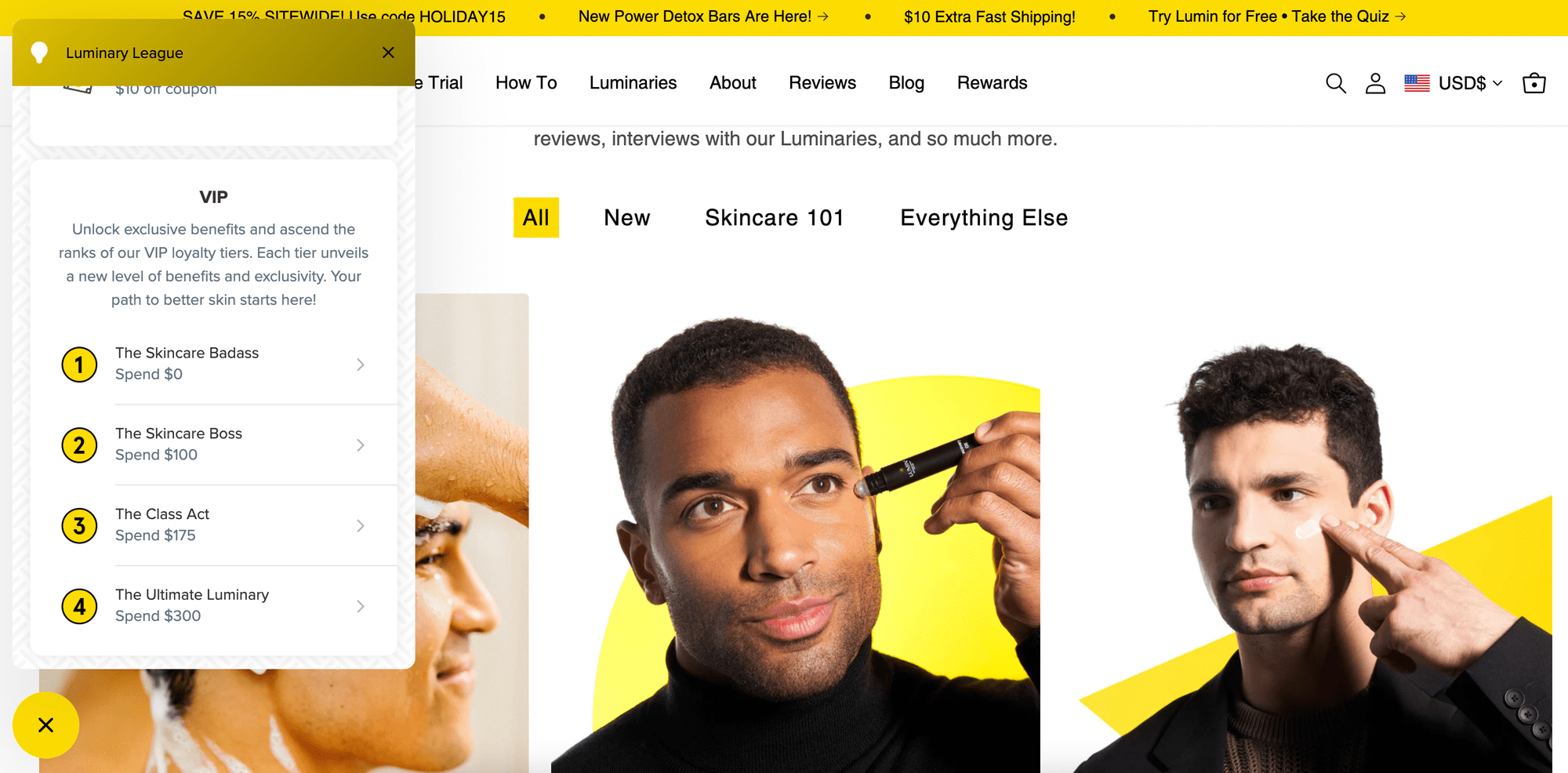
Step 7: Create a visual explainer page
A visual explainer page is one of the easiest ways to drive loyalty program participation and engagement. Explainer pages are a key component of a successful loyalty program.
It also signifies to your customers that you care by creating a place where they can get all their questions answered on your loyalty program. More importantly, it tells them how they’ll benefit by joining. The more visual, the better.
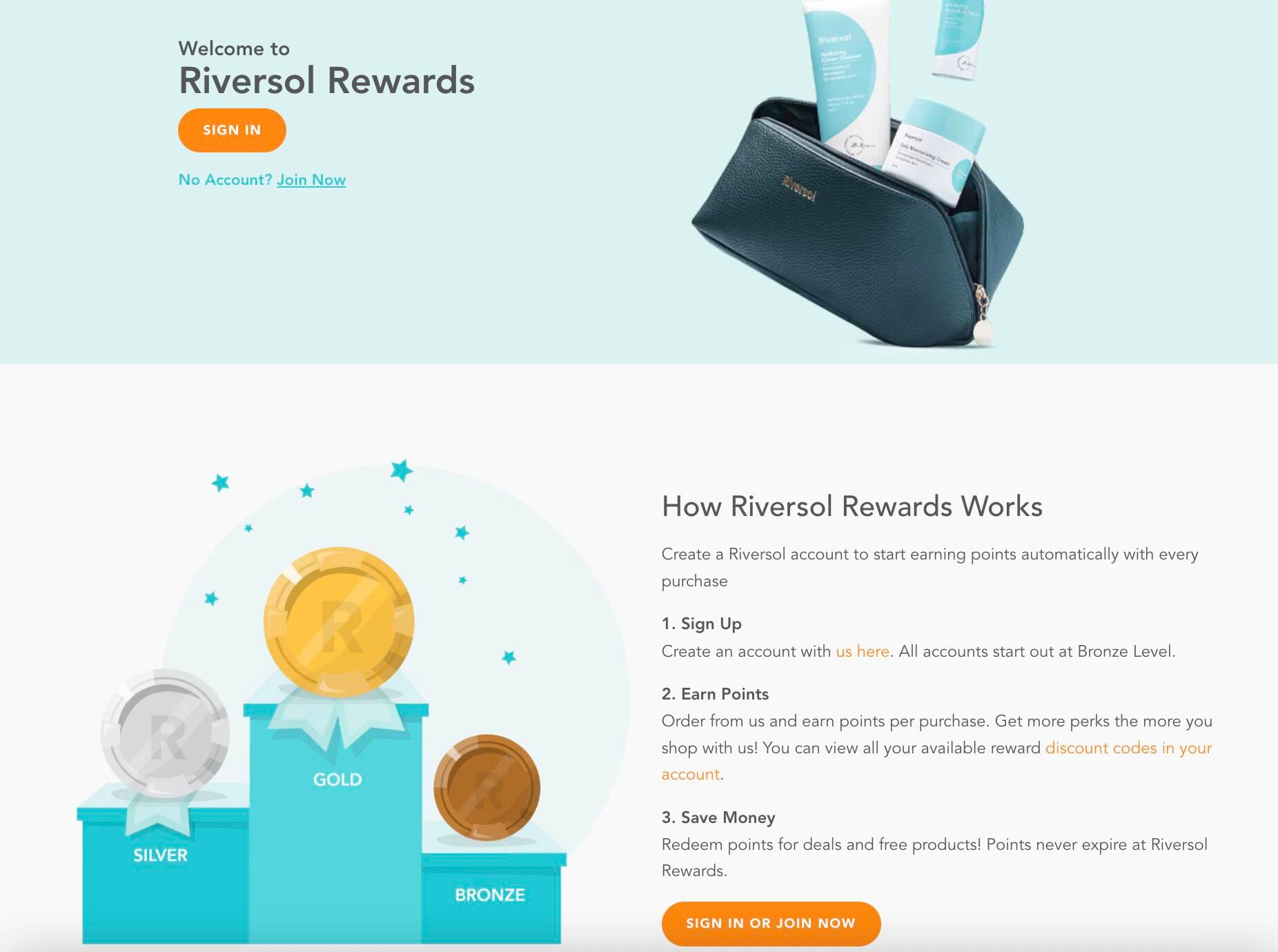
An effective explainer page should:
- Excite customers about the program’s benefits.
- Explain how the program works and how customers can participate.
- Ultimately, convince the customer to participate.
With Smile Plus you have the capability to be able to create a loyalty landing page in a few simple clicks, right within the Smile app. Embed an SEO-friendly loyalty landing page directly into your storefront, and no coding is required.

Tips for building a great explainer page:
- Make your explainer page easy to find on your website.
- Have a clear call to action (CTA).
- Make it easy for customers to understand.
- Showcase your motivator and why customers should join.
Shopify Plus Loyalty Program Examples
Earning skulls with Liquid Death
If there is one brand that perfectly brands its loyalty program, it’s Liquid Death. From its brand copy - “...earn skulls for buying, sharing, and shamelessly promoting Liquid Death. Then, trade in your skulls for even cooler free sh*t…” to its currency name, Skulls, Liquid Death’s loyalty program is an extension of the overall brand identity. Customers can earn 1 point for every dollar they spend and redeem rewards such as free products.
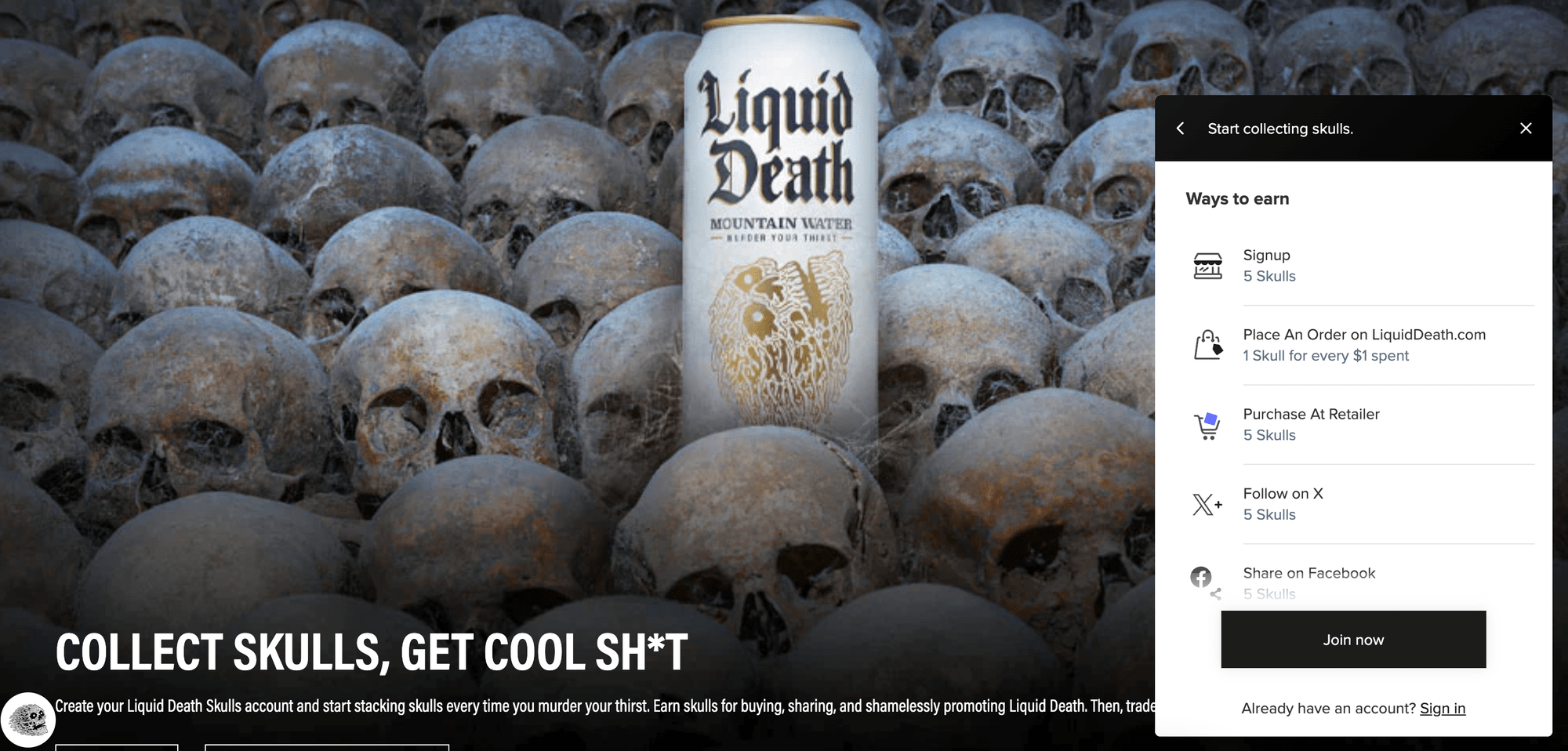
One aspect of Liquid Death’s loyalty program is that customers can scan receipts if they bought a Liquid Death can from a retailer. As Liquid Death grows and expands into grocery stores and retail spaces, this is an important way to lock in customers who don’t come in through an online sale. You can easily retarget these customers to place orders online later.
Monos
By offering customers incentives through its Wayfarer Rewards program, Monos has generated $8 million in Smile-Generated value since launching its program in 2020. This includes customers placing an order with a Smile.io rewards code, whether from a rewards redemption or through a referral. Active program participants in Wayfarer Rewards purchased nearly 2x more often than other customers.
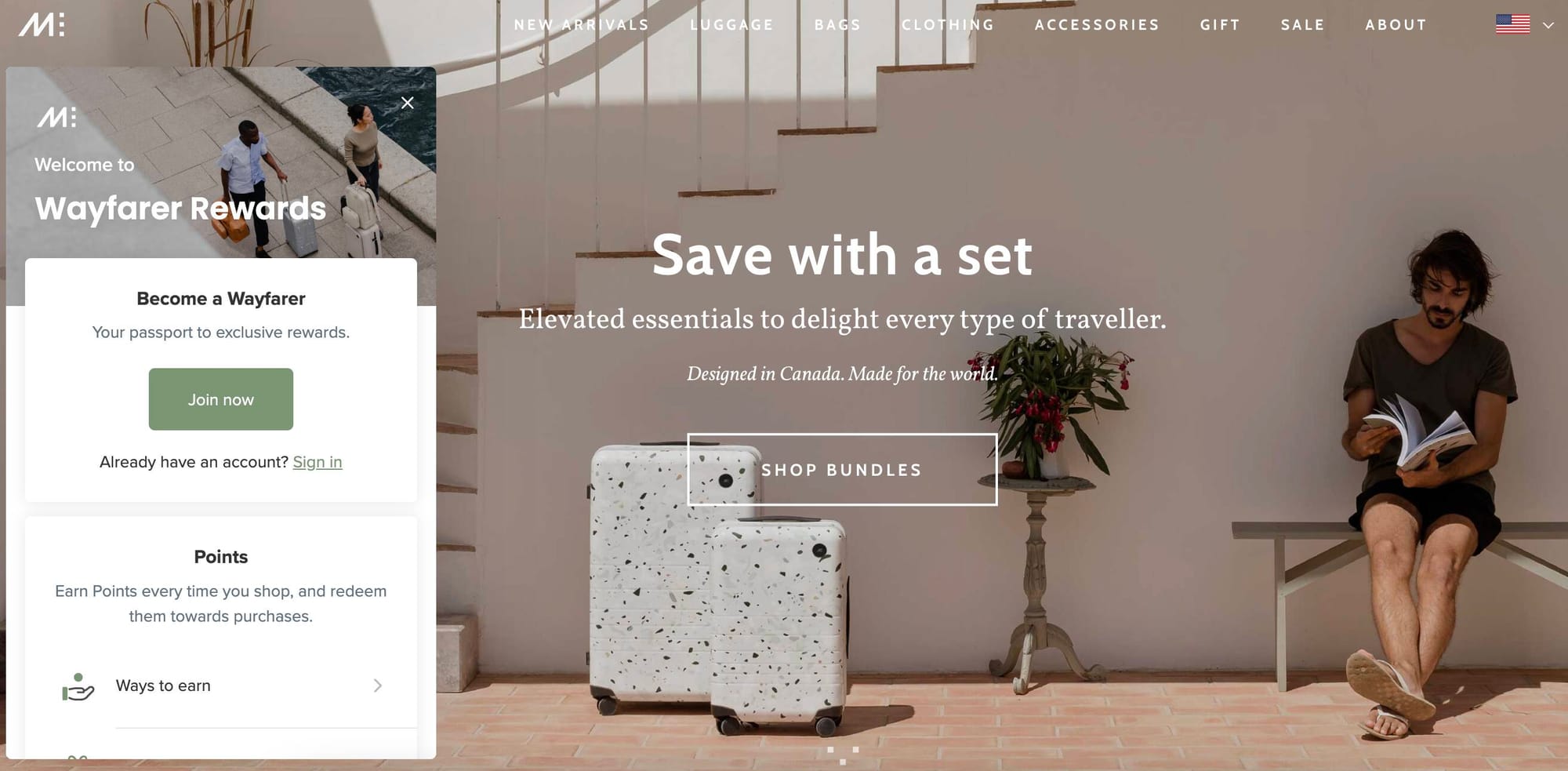
Launch your Shopify Plus loyalty program
Customer loyalty is important because a base of loyal customers will drive repeat purchases, increase AOV (average order value), and have an overall increase in customer lifetime value. Building customer loyalty is an opportunity to build a community that will support you no matter what (and choose you over competitors).
Implementing a loyalty program can help bring customers back to your store, build a loyal following, and boost customer lifetime value (CLV) and repeat purchase rates. This makes your customers valuable and an asset worth investing in.
